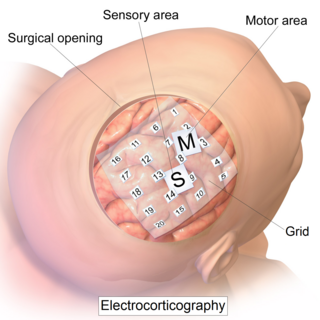
Neuroscience is the scientific study of the nervous system, its functions and disorders. It is a multidisciplinary science that combines physiology, anatomy, molecular biology, developmental biology, cytology, psychology, physics, computer science, chemistry, medicine, statistics, and mathematical modeling to understand the fundamental and emergent properties of neurons, glia and neural circuits. The understanding of the biological basis of learning, memory, behavior, perception, and consciousness has been described by Eric Kandel as the "epic challenge" of the biological sciences.

A brain–computer interface (BCI), sometimes called a brain–machine interface (BMI) or smartbrain, is a direct communication pathway between the brain's electrical activity and an external device, most commonly a computer or robotic limb. BCIs are often directed at researching, mapping, assisting, augmenting, or repairing human cognitive or sensory-motor functions. They are often conceptualized as a human–machine interface that skips the intermediary component of the physical movement of body parts, although they also raise the possibility of the erasure of the discreteness of brain and machine. Implementations of BCIs range from non-invasive and partially invasive to invasive, based on how close electrodes get to brain tissue.
BrainGate is a brain implant system, currently under development and in clinical trials, designed to help those who have lost control of their limbs, or other bodily functions, such as patients with amyotrophic lateral sclerosis (ALS) or spinal cord injury. The Braingate technology and related Cyberkinetic’s assets are now owned by privately held Braingate, Co. The sensor, which is implanted into the brain, monitors brain activity in the patient and converts the intention of the user into computer commands.
Brain implants, often referred to as neural implants, are technological devices that connect directly to a biological subject's brain – usually placed on the surface of the brain, or attached to the brain's cortex. A common purpose of modern brain implants and the focus of much current research is establishing a biomedical prosthesis circumventing areas in the brain that have become dysfunctional after a stroke or other head injuries. This includes sensory substitution, e.g., in vision. Other brain implants are used in animal experiments simply to record brain activity for scientific reasons. Some brain implants involve creating interfaces between neural systems and computer chips. This work is part of a wider research field called brain–computer interfaces.
In neuroscience, single-unit recordings provide a method of measuring the electro-physiological responses of a single neuron using a microelectrode system. When a neuron generates an action potential, the signal propagates down the neuron as a current which flows in and out of the cell through excitable membrane regions in the soma and axon. A microelectrode is inserted into the brain, where it can record the rate of change in voltage with respect to time. These microelectrodes must be fine-tipped, impedance matching; they are primarily glass micro-pipettes, metal microelectrodes made of platinum, tungsten, iridium or even iridium oxide. Microelectrodes can be carefully placed close to the cell membrane, allowing the ability to record extracellularly.

Electrocorticography (ECoG), a type of intracranial electroencephalography (iEEG), is a type of electrophysiological monitoring that uses electrodes placed directly on the exposed surface of the brain to record electrical activity from the cerebral cortex. In contrast, conventional electroencephalography (EEG) electrodes monitor this activity from outside the skull. ECoG may be performed either in the operating room during surgery or outside of surgery. Because a craniotomy is required to implant the electrode grid, ECoG is an invasive procedure.
Neuroergonomics is the application of neuroscience to ergonomics. Traditional ergonomic studies rely predominantly on psychological explanations to address human factors issues such as: work performance, operational safety, and workplace-related risks. Neuroergonomics, in contrast, addresses the biological substrates of ergonomic concerns, with an emphasis on the role of the human nervous system.

The sensorimotor mu rhythm, also known as mu wave, comb or wicket rhythms or arciform rhythms, are synchronized patterns of electrical activity involving large numbers of neurons, probably of the pyramidal type, in the part of the brain that controls voluntary movement. These patterns as measured by electroencephalography (EEG), magnetoencephalography (MEG), or electrocorticography (ECoG), repeat at a frequency of 7.5–12.5 Hz, and are most prominent when the body is physically at rest. Unlike the alpha wave, which occurs at a similar frequency over the resting visual cortex at the back of the scalp, the mu rhythm is found over the motor cortex, in a band approximately from ear to ear. People suppress mu rhythms when they perform motor actions or, with practice, when they visualize performing motor actions. This suppression is called desynchronization of the wave because EEG wave forms are caused by large numbers of neurons firing in synchrony. The mu rhythm is even suppressed when one observes another person performing a motor action or an abstract motion with biological characteristics. Researchers such as V. S. Ramachandran and colleagues have suggested that this is a sign that the mirror neuron system is involved in mu rhythm suppression, although others disagree.
Brain technology, or self-learning know-how systems, defines a technology that employs latest findings in neuroscience. [see also neuro implants] The term was first introduced by the Artificial Intelligence Laboratory in Zurich, Switzerland, in the context of the Roboy project. Brain Technology can be employed in robots, know-how management systems and any other application with self-learning capabilities. In particular, Brain Technology applications allow the visualization of the underlying learning architecture often coined as “know-how maps”.

Cybathlon, a project of ETH Zurich, acts as a platform that challenges teams from all over the world to develop assistive technologies suitable for everyday use with and for people with disabilities. The driving force behind CYBATHLON is international competitions and events, in which teams consisting of technology developers from universities, companies or NGOs and a person with disabilities (pilot) tackle unsolved everyday tasks with their latest assistive technologies. Besides the actual competition, the Cybathlon offers a benchmarking platform to drive forward research on assistance systems for dealing with daily-life challenges, and to promote dialogue with the public for the inclusion of people with disabilities in society. The involvement of the pilot is considered essential both to the competition and in the development process, to ensure that the perspective and needs of end users are considered and addressed.
A cortical implant is a subset of neuroprosthetics that is in direct connection with the cerebral cortex of the brain. By directly interfacing with different regions of the cortex, the cortical implant can provide stimulation to an immediate area and provide different benefits, depending on its design and placement. A typical cortical implant is an implantable microelectrode array, which is a small device through which a neural signal can be received or transmitted.
Clinatec is a biomedical research center based at the Polygone Scientifique in Grenoble. Doctors, biologists and micro- and nanotechnology experts work side by side at the 6,000 m2 facility. Around a hundred researchers and employees work at the center. When it opened at the end of 2011, it was hailed as the first center of its kind in the world. With six hospital rooms, cutting-edge medical imaging equipment and an operating suite, Clinatec was developed by the Research Division of the CEA, Grenoble-Alpes University Hospital (CHU), Inserm and the Université Grenoble Alpes. The primary focus is on cancer, neurodegenerative diseases and disability.
Neuro-Information-Systems (NeuroIS) is a subfield of the information systems (IS) discipline, which relies on neuroscience and neurophysiological knowledge and tools to better understand the development, use, and impact of information and communication technologies. The field has been formally established at the International Conference on Information Systems (ICIS) in 2007.
Neural dust is a hypothetical class of nanometer-sized devices operated as wirelessly powered nerve sensors; it is a type of brain–computer interface. The sensors may be used to study, monitor, or control the nerves and muscles and to remotely monitor neural activity. In practice, a medical treatment could introduce thousands of neural dust devices into human brains. The term is derived from "smart dust", as the sensors used as neural dust may also be defined by this concept.

Paul Hunter Peckham is a professor of biomedical engineering and orthopedics at the Case Western Reserve University, and holds eight patents related to neural prosthetics. Peckham's research involves developing prostheses to restore function in the upper extremities for paralyzed individuals with spinal cord injury.
Neuropixels probes are electrodes developed in 2017 to record the activity of hundreds of neurons in the brain. The probes are based on CMOS technology and have 1,000 recording sites arranged in two rows on a thin, 1-cm long shank.

The Robert J. & Nancy D. Carney Institute for Brain Science is a cross-departamental neuroscience research institute at Brown University in Providence, Rhode Island. The institute's core focus areas include brain-computer interfaces and computational neuroscience The institute also focuses on research into mechanisms of cell death with the interest of developing therapies for neurodegenerative diseases.

Chet T. Moritz is an American neural engineer, neuroscientist, physiologist, and academic researcher. He is a Professor of Electrical and Computer Engineering, and holds joint appointments in the School of Medicine departments of Rehabilitation Medicine, and Physiology & Biophysics at the University of Washington.

Leigh Robert Hochberg is an American neurologist, neuroscientist, and neuroengineer. He is the Director of the Center for Neurotechnology and Neurorecovery at Massachusetts General Hospital and the L. Herbert Ballou University Professor of Engineering at Brown University. He is also affiliated with the VA RR&D Center for Neurorestoration and Neurotechnology. Hochberg is known with his involvement in BrainGate and brain-computer interface research more broadly. In 2021, he led a clinical trial demonstrating the first high-bandwidth wireless human brain-computer interface.

Thorsten O. Zander is a German scientist who introduced the concept of passive brain-computer interface. He co-founded Zander Labs, a German-Dutch company in the field of passive brain computer interface (pBCI) and neuro-adaptive technology (NAT).








